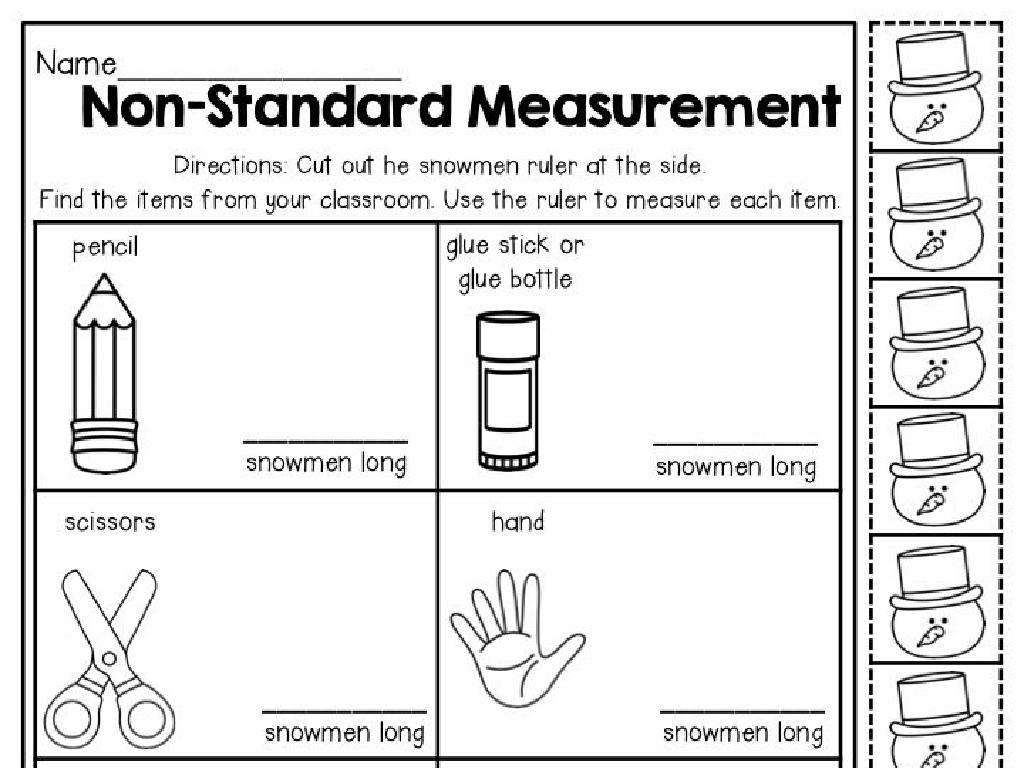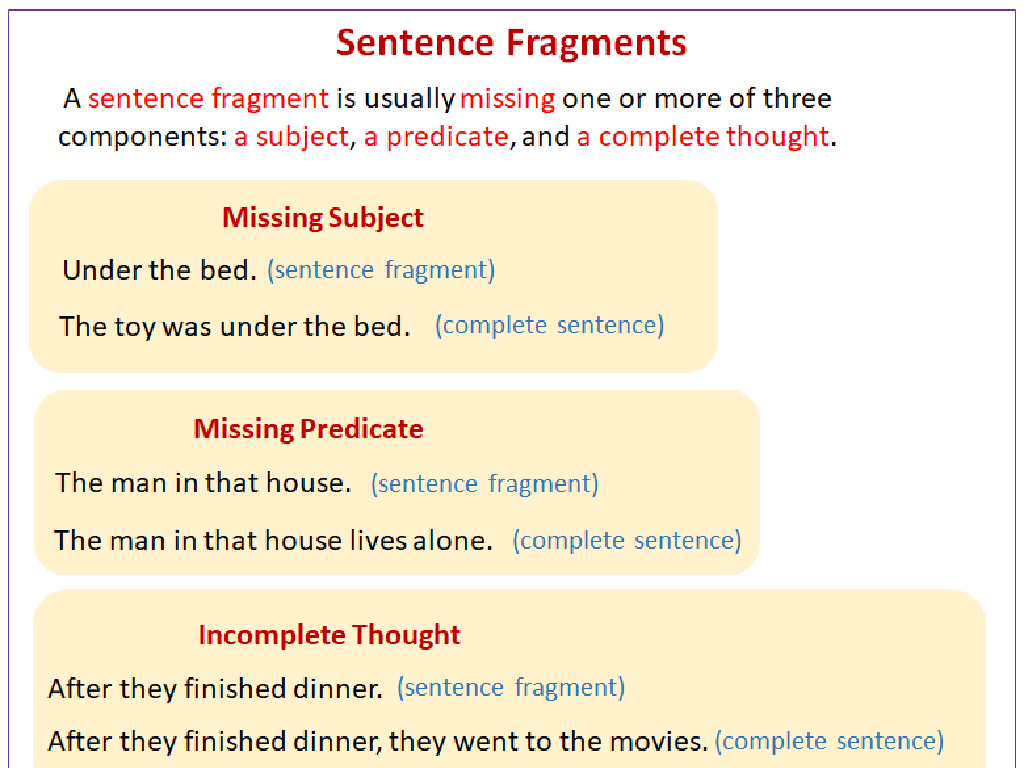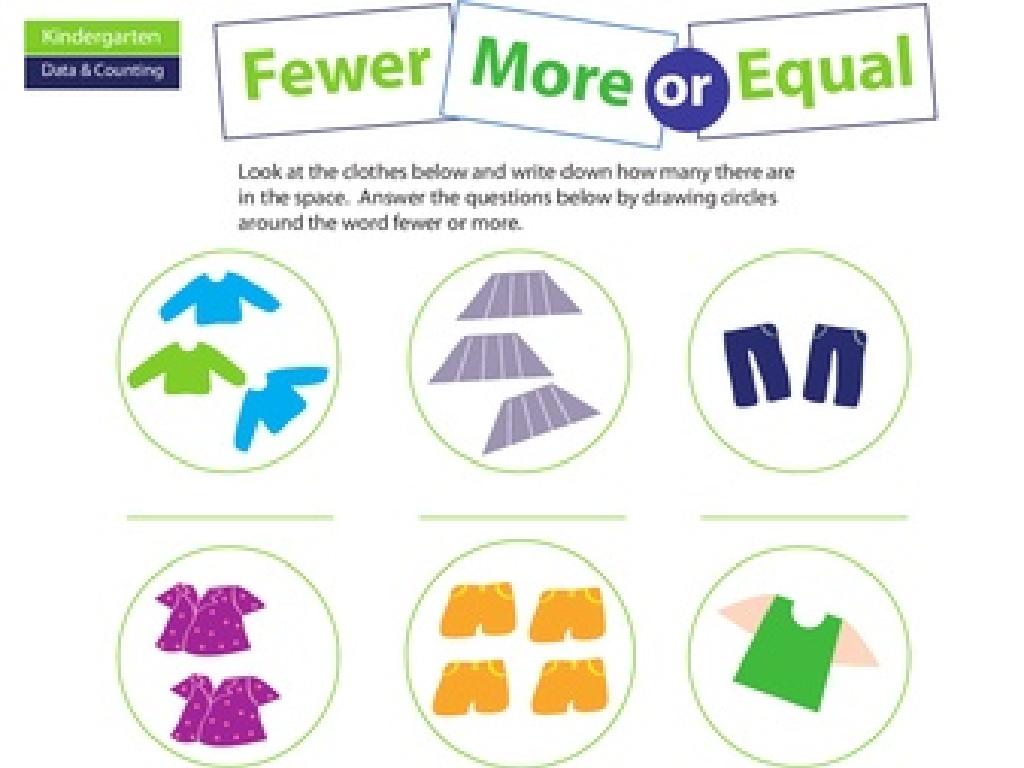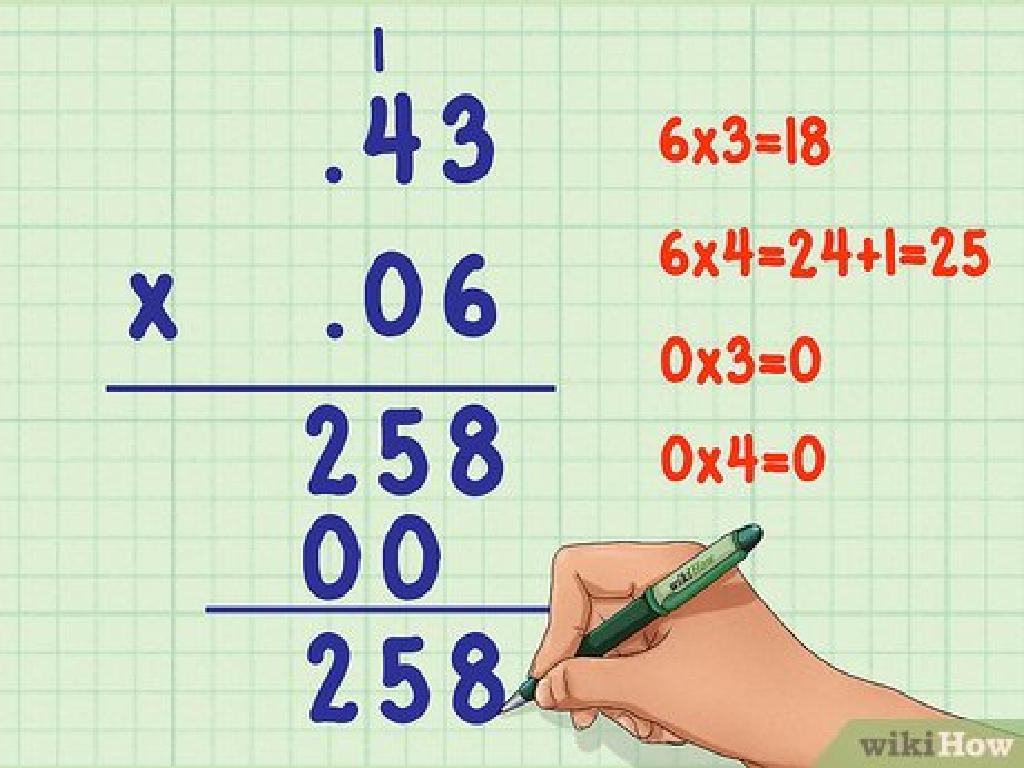Classify Objects By Texture
Subject: Science
Grade: Kindergarten
Topic: Materials
Please LOG IN to download the presentation. Access is available to registered users only.
View More Content
Exploring Textures in Materials
– Welcome to our Science Class!
– Today’s topic: Learning about Materials
– We will explore different textures
– Textures can be smooth, rough, soft, or hard
– Understanding ‘Texture’
– Texture is how something feels when we touch it
|
Begin the class with a warm welcome and introduce the topic of Materials, focusing on textures. Explain that texture refers to the way things feel to our touch. Provide a variety of materials with different textures for the children to touch and feel, such as cotton balls (soft), sandpaper (rough), silk (smooth), and wooden blocks (hard). Encourage the children to describe what they feel and to understand that texture is an attribute that helps us classify and understand the world around us. This hands-on experience will help them grasp the concept of texture in a tangible way.
Exploring Textures
– What is texture?
– Texture is the way things feel.
– Types of textures
– Smooth, rough, soft, hard are some types.
– Identifying smooth objects
– Glass is smooth, can you find more?
– Identifying rough objects
– Sandpaper is rough, what else is?
|
This slide introduces the concept of texture to Kindergarten students. Begin by explaining that texture refers to how the surface of an object feels to the touch. Provide examples of different textures such as smooth, rough, soft, and hard, and encourage students to think of their own examples. You can bring in objects with various textures for a hands-on experience. Ask the children to touch and feel the objects and describe the textures they sense. This will help them understand the concept of texture and how to classify objects based on it. Make sure to supervise the activity to ensure safety and guide the students in their exploration.
Exploring Textures Around Us
– Textures are everywhere
– Look at the things around you, they feel different!
– Use eyes and hands to discover
– See how things look, then touch them to learn more
– Feel textures with our hands
– Soft, rough, bumpy, or smooth? Let’s find out by touching
– Learn to describe textures
– Is it hard or squishy? Let’s use words to talk about it
|
This slide introduces the concept of texture to Kindergarten students. It’s important to make the learning experience interactive by encouraging the children to use their senses to explore their environment. Have a variety of materials available for them to touch, such as cotton balls, sandpaper, silk, and sponges. Guide them to describe what they feel using simple adjectives. This activity will help them understand the concept of texture and how to classify objects based on how they feel. Encourage them to use their new vocabulary to describe the textures they encounter.
Exploring Smooth Textures
– Smooth objects feel slick
– They have no bumps or roughness
– Examples: Glass and Marble
– Think of a window or kitchen counter
– Let’s touch and feel smooth objects!
– We’ll pass around items to touch
|
This slide introduces the concept of smooth textures to Kindergarten students. Begin by explaining that smooth textures are surfaces that are even and flat, with no bumps or rough areas. Use familiar examples like glass windows or marble countertops to help them relate. During the activity, provide a variety of smooth objects for the children to touch and feel, such as polished stones, pieces of glass, or tiles. Encourage them to describe the texture and compare it with other textures they know. This tactile activity will help reinforce their understanding of ‘smooth’ as a texture category.
Exploring Rough Textures
– Rough textures feel bumpy
– They can scratch your skin
– Examples: Sandpaper, Rocks
– Sandpaper is used for smoothing things but feels rough. Rocks from outside can be rough too.
– Let’s touch and feel rough objects!
– We will pass around objects to touch and describe the texture.
|
This slide introduces the concept of rough textures to Kindergarten students. Begin by explaining that textures describe how things feel when we touch them. Rough textures are not smooth; they have an uneven surface that can be bumpy and might scratch if we’re not gentle. Show the students examples of rough objects like sandpaper and rocks. Have a tactile activity where students can safely touch and feel objects with rough textures. Encourage them to use their words to describe how these objects feel. This hands-on experience will help solidify their understanding of rough textures in the context of learning about different materials.
Exploring Soft Textures
– What are soft textures?
– Soft textures are squishy and nice to touch
– Examples of soft things
– Like cotton balls and fluffy pillows
– Touch and feel activity
– We will touch different items to learn about softness
– Discuss our findings
|
This slide introduces the concept of soft textures to Kindergarten students. Begin by explaining that soft textures are usually squishy and feel pleasant when we touch them. Show examples of soft items such as cotton balls and pillows. Then, engage the students in a hands-on activity where they can touch and feel various objects to understand what ‘soft’ means. After the activity, have a discussion with the students about what they felt and which objects they thought were the softest. This will help them to associate the tactile experience with the concept of softness and to use descriptive language to express their observations.
Exploring Hard Textures
– Hard things are solid and tough
– Examples: Brick, Metal Toy
– Bricks build houses, metal toys are strong
– Touch to discover hard textures
– Feel the surface of these objects with your hands
– Discuss the feeling of hardness
– Is it smooth or bumpy? Is it difficult to press?
|
This slide introduces the concept of hard textures to Kindergarten students. Begin by explaining that hard objects are solid and can’t be squished easily. Show them examples of hard objects like a brick or a metal toy, and if possible, have these objects available for the students to touch. Encourage the children to feel the surface of the objects and describe what they sense. Is it smooth, rough, or bumpy? Can they bend or press it easily? This tactile activity will help them understand the concept of ‘hardness’ in a practical and engaging way. Make sure to supervise the children to ensure safety while they handle the objects.
Class Activity: Texture Hunt!
– Let’s explore textures around us
– Find smooth, rough, soft, and hard objects
– Use your worksheet for your discoveries
– Your worksheet has spaces for each texture type
– Draw or write down your texture finds
– You can draw the object or write the object name
|
This activity is designed to engage students in a hands-on learning experience about textures. Encourage the children to touch and feel various objects in the classroom to determine their textures. Provide each student with a Texture Hunt Worksheet that has sections labeled ‘smooth’, ‘rough’, ‘soft’, and ‘hard’. Guide them to draw or write the name of the objects they find for each texture category. As they work, circulate the room to assist and ask questions that prompt them to think about the textures they’re feeling. After the hunt, regroup and discuss the different textures found. This will help reinforce their understanding of the concept of texture in a tangible way. Prepare a variety of objects beforehand to ensure that there are enough examples for each texture type.
Share What We Found: Textures Around Us
– Gather in a circle with friends
– Show and tell about textures
– Bring your object and describe how it feels
– Classify textures as a group
– Is it rough, smooth, soft, or hard?
– Discuss what makes each texture unique
– Why is a teddy bear soft but a rock is hard?
|
This slide is meant to facilitate a group activity where students will share objects they’ve found and discuss the different textures. Encourage each child to participate by showing the class the object they’ve brought and describing its texture. Guide the class to work together to classify the objects based on their textures, asking questions to help them think about why objects feel the way they do. This activity will help students understand the concept of texture and how to categorize objects based on this property. It’s also a great opportunity for developing social skills and language as they describe and discuss their findings.
Fantastic Texture Explorers!
– Celebrating our Texture Hunt
– Classifying objects by texture
– We sorted things based on how they feel.
– Texture: the feel of surfaces
– Smooth, rough, soft, hard are all textures.
– Keep exploring textures around you!
|
Well done to all the students for completing the Texture Hunt activity! Today, we’ve learned about different textures and practiced classifying objects based on how their surfaces feel to the touch. Remember, texture refers to the tactile quality of an object’s surface it can be smooth, rough, soft, or hard, among others. Encourage the children to continue exploring and feeling the textures of objects around them at home or in the classroom. This will help reinforce their understanding of the concept and allow them to apply it in various contexts.






